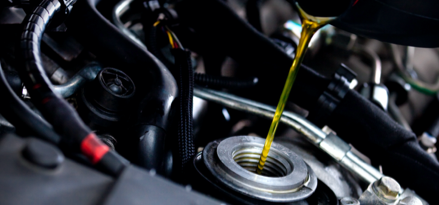
Everything you need to know about viscosity
The oil property you should think about first when considering engine protection is “viscosity”. For many seasoned drivers, the word itself remains a riddle wrapped in a designation code enigma. But it’s not as complicated as it may seem.
Put simply, viscosity determines the speed that oil flows. A viscosity that is too high requires more energy to flow as it is less efficient and economical.
-

Choosing the right oil viscosity for your car
Unfortunately, you can’t just assume that a higher viscosity oil will always be better for your engine due to such pesky factors as fuel economy, engine design and power.
To protect your vehicle against engine wear, it’s essential that you pick the right viscosity. Lucky for you, it’s not hard to find a definitive answer. A swift consultation of your owner’s manual should specify which viscosity designation is right for your engine.
-

What exactly is a viscosity designation?
5W-20, 5W-30, 10W-30 or 10W-40? The viscosity grade that’s printed on every bottle of engine oil determines how it will react to changes in temperature.
The first part of the viscosity designation (the W grade) tells us the product's ability to help an engine crank and start, and for the engine to pump the lubricant. The lower the number (0W is the lowest), the lower the temperature at which the product can be used.
Think of the W grade as the lowest temperature your engine sees on the coldest morning of the year. At the same time, a lower W grade pumps and helps an engine to start better than a higher W grade.
The second part conveys the viscosity your engine sees at operating temperature. In this case, a higher number is a higher viscosity grade and provides more viscous oil at operating temperature than lower viscosity grade oil.
-

Is all that viscosity sinking in?
Let’s break down Mobil 1™ 5W-30, recommended for all types of modern gasoline-powered vehicles including the high-performance turbocharged, supercharged or multi-valve fuel injected engines.
The “5W” in the name refers to the oil’s ability to flow in cold temperatures. Meanwhile, the “30” describes the fluid’s ability to flow at a vehicle’s normal operating temperature, which is 100°C.
-

Should my oil choice change as my vehicle gets older?
Yes, your car’s preferences will change with time. Vehicles with older engines benefit from thicker oils that prevent friction and oil loss whereas newer vehicles benefit from thinner oils for faster lubrication of new engine parts.
If older engines are not replaced with high-viscosity oil, it can lead to problems such as noisiness and increased wear. This is important to consider as your vehicle enters more advanced stages of its lifecycle.
-

Stay viscous with Mobil 1 and Mobil Super™ engine oils
Understanding the nature of viscosity and how it affects your vehicle is vital in ensuring your engine’s longevity. For outstanding engine performance and protection your car deserves, consult your owner’s manual and use Mobil 1 and Mobil Super engine oils.




